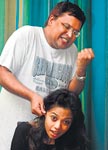
A walk on the mild sideIn the end there was no need to fear a sudden migraine or to reach for a large glass of water. StageLight and Magic’s second serving of NOIR (extra dark theatre fest), which promised to be as dark as chocolate, black coffee or extra strong stout, was really rather sweet. On this evidence, perhaps SLM shouldn’t send director Anuruddha Fenando and producer Chalaka Gajabahu off to the supermarket on their own in future. If the evening was chocolate, it was definitely dairy milk; not an espresso but a latte washed down with EGB. The twin treats offered on July 13, 14 and 15 were Eugene Ionesco’s The Lesson preceded by Eric Bogosian’s very short The Specialist. Ifaz Bin Jameel gave a discrete and suitably understated performance as the guest lecturer addressing an audience of practitioners in his specialist field, torture. The tools of the trade, the bucket, the firm grip, a guttered restraining table, cigarettes, a pair of pliers and the application of electrodes were each introduced warmly, like dear old friends.
Bin Jameel’s disarming smile and knowing nods stealthily encouraged the audience’s collusion, until the asides about ‘yelps of pain’ or ‘tears and choking’ yielded a laugh or two. Once the bridge had been crossed, the audience relaxed, unthinkingly giving its approval to the use of torture as each technique was explained. But the horror of this collusion, which should have been felt as the lights went out, failed to materialize. Bin Jameel’s exhortations to his audience not to live in the dark ages in their choice of techniques and tools for torture, can now all too easily be flung back at Bogosian’s play. ‘The bucket and firm grip’ technique has been superseded by the more effective and inventive application known as ‘waterboarding’; torturers no longer restrain using straps, but suspend their prisoners upside down from cranes; surely there is a need now to mention the positive benefits to be gained from ‘sleep deprivation’ using light and sound and so too the controlled use of dogs? And why no mention in the lecture of the new developments in psychological torture: the opportunities offered by exploiting cultural homophobia, the sight of naked women or by publicly defiling the Quran? Rather than the shock of the audience’s swift acceptance of torture, the response to Bogosian’s play now is more to urge the guest lecturer to get off the lecture circuit and get back out into the field. He may have missed the chance to refresh his lecture notes at the recently closed Institute for Inhuman Treatment at Abu Ghraib or to hop on a Rendition Flight to Eastern Europe, but still you feel there are plenty of 21st century chances for him to update his lecture notes on torture and for our fictional guest lecturer to meet real specialists lecturing on the finer points of the use of torture, with whom he can exchange notes, powerpoints and video tapes. So the shock and horror that the play generates now are not directed at the audience’s complicity in approving torture, but the realisation that political leaders around the world have and continue to sanction and defend the use of torture as they pursue their ‘wars on terror’. Unfortunately for Bogosian and SLM, in this case, fact has become a whole lot darker than theatre. In Ionesco’s The Lesson the darkness begins to emerge towards the end of the play and only shows its full and horrific form at the denouement. Michael Holsinger’s portrayal of the Professor charts a steady course throughout the play. Entering as a well respected local figure, an affable and charming academic, the Professor soon begins his descent into full blown ranting madness. Michael’s performance as the Professor was outstanding, from the bumbling hesitant beginning, through the brain bending explanations of crazed calculus and illogical linguistics, to the outburst of madness with which the play ends. The performance was outstanding also in the sense that it went went largely unsupported by either Shehara Jayasinghe as the student, or Aida Mansoor as the maid. Shehara spent almost the entire play looking bored--the boredom of a teenager vacantly transfixed from watching too much MTV. Neither did her character mirror the Professor’s descent into madness by responding in any way to the mounting absurdity. Instead, her replies to the Professor’s questions were characterized by monotonous petulance or were delivered in an even more irritating whine. As a consequence, rather than being horrified by the Professor’s rush of madness and the murder of yet another student, there was a sense of relief that at least her toothache had been cured once and for all. It is only at this point in the play that the maid’s dark conspiracy in both the Professor’s madness and the serial death of his students becomes apparent. In this context her jovial demeanour earlier in the play and again at its end certainly felt absurd, but it didn’t leave behind the devilishly dark, noirish aftertaste we’d been promised on the wrapper. |
|| Front
Page | News | Editorial | Columns | Sports | Plus | Financial
Times | International | Mirror | TV
Times | Funday
Times || |
| |
Copyright
2007 Wijeya
Newspapers Ltd.Colombo. Sri Lanka. |
